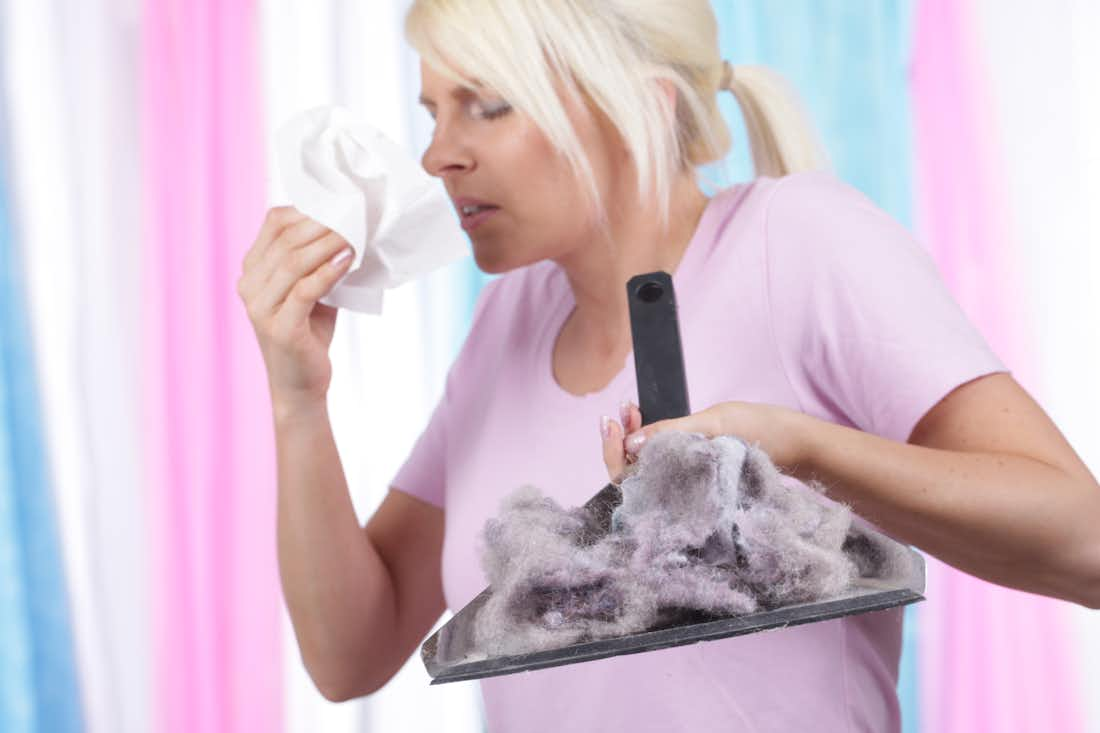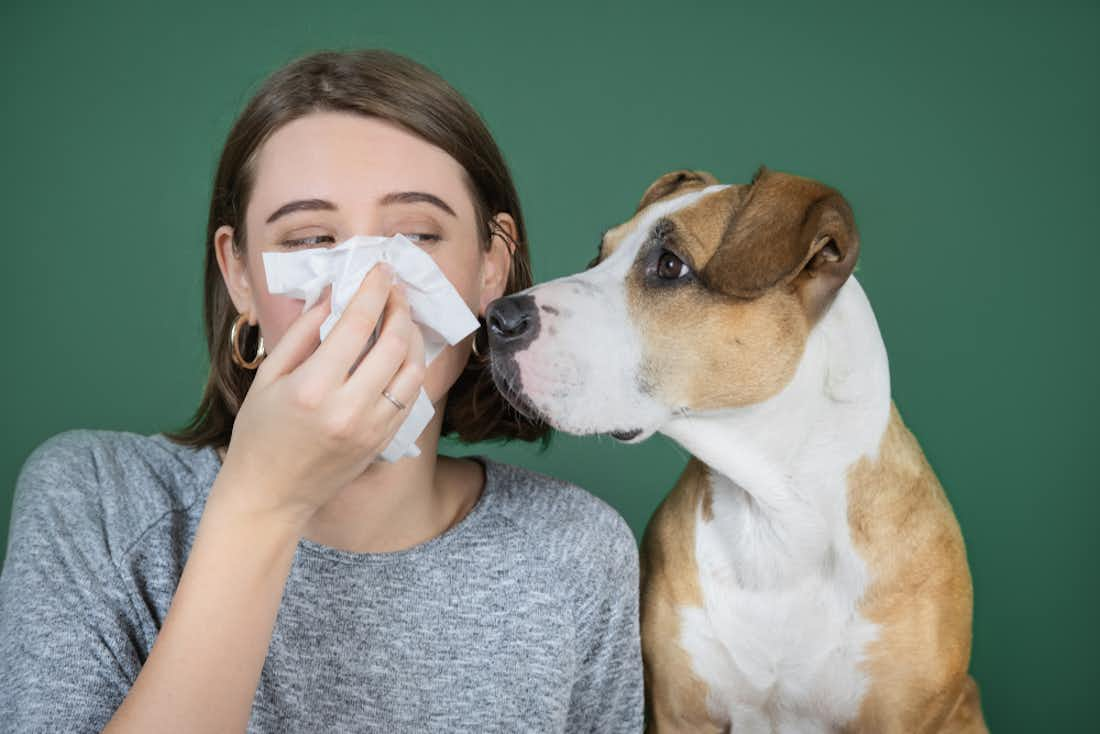Oct 13, 2022
What Is an Allergy Headache and How To Treat It
5 minute read
Allergy symptoms like sneezing and sniffling can be a major headache. But allergy headaches can make that headache even more of a headache, literally.
The good news is that, just like other allergy symptoms, you can alleviate the pressure without added stress. Here’s what causes an allergy headache, as well as some of our tried and true ways to treat it.
What Is an Allergy Headache?
If you’ve ever suffered from headaches, you’ve probably seen that they don’t all feel the same. Believe it or not, there are over 150 different types of headaches.
With that said, two types of headaches are typically linked to allergies: migraines and sinus headaches. Migraines usually feel like throbbing pain on one side of the head. These hurt so much that some people experience nausea, vomiting, and increased sensitivity to light when they arise.
On the other hand, sinus headaches are a more dull pain over the sinuses. The pain might feel like a nagging pain in your cheeks, forehead, or on the bridge of your nose.
Sometimes, people wrongfully mistake cluster headaches for allergy headaches – though there is no known correlation. Cluster headaches are the most severe type of headache, and they usually feel like an intense throbbing pain behind the eye.
What Causes an Allergy Headache?
Your sinus cavities are a hollow space inside of your skull. It has openings in the nose to drain mucus and allow airflow. These cavities extend inside of the cheeks, behind the eyes, and behind the nose into the forehead.
When your body encounters an allergen, it can cause swelling within the nasal cavities. This swelling can block those openings and increase the pressure inside your sinuses. That build-up is what causes the sensation of an allergy headache.
Allergy headaches are usually more intense in the morning after a long period of lying down because your blood pressure changes when you lie down, causing blood to “pool” near your sinuses. However, you can sometimes feel some relief once you stand up or move into an upright position.
How To Treat Allergy Headaches
As easy as it is for allergy headaches to come about, it’s equally easy to get rid of them. Here are a few ways to mitigate those migraines and feel better in no time.
Treat the Allergies Themselves
If the allergies are causing your headaches, eliminating them is the perfect place to start. Plus, squashing your allergies can reduce some of those other inundating symptoms like runny nose, coughing, itchy eyes, and sore throat, too.
There are plenty of different ways to treat allergies. One method is with antihistamine medications like fexofenadine or cetirizine. Histamines are a chemical that your body produces when exposed to an allergen, and this chemical spurs the cascade of symptoms you know and hate.
As their name implies, antihistamines block the effects of histamines to lessen your symptoms and improve your overall comfort.
Oral antihistamines are common all-around remedies, but you can also use nasal sprays to combat sinus symptoms. This method might be beneficial if you have a sinus headache related to your allergies.
With that said, antihistamines don’t truly treat allergies – they just alleviate the symptoms. Allergy immunotherapy is your go-to method to take it a step further and pinpoint the underlying cause.
Sublingual immunotherapy, or SLIT, gradually exposes you to small amounts of an allergen over an extended period. This method allows your immune system to build up a tolerance so that the given allergen is no match for you. All you need to do is place a tablet under your tongue every day during your treatment. There are no needles and no pain – but there’s still a lot to gain!
Join the 90% of people who reported improvement in their general health status from a prescribed allergy immunotherapy treatment. Take your free allergy consultation to see if you qualify for this revolutionary remedy for those nagging allergies.
Warm or Cold Compress
Relieving sinus pressure can put you under a lot of stress, but for some people, it might be as simple as warming up a towel and placing it over your forehead.
The heat from the towel opens up your sinuses by easing the swelling within your nasal passageways. All you need to do is run the towel under warm water. Then, wring it out to feel damp but not soaking. Finally, lay down, fold the towel, and place it on your forehead just around the bridge of your nose. It’s simple and relaxing, and you can do it as often as you want.
Some people also find relief by supplementing the warm compress with a cold compress every three to five minutes. There’s not any scientific evidence to show that this works, but many people use this method to alleviate pressure. It’s worth a try if that sinus headache just won’t go away with a warm compress alone.
Clear Your Sinuses
If your allergy headache is caused by sinus pressure, you may also be able to find some relief by clearing out those passageways and keeping them squeaky clean.
There are a few different ways to clear your sinuses, but one of our favorite methods is using a neti pot. This method is a form of nasal irrigation where you deliver a stream of saltwater into one nostril, which naturally flows the rest of the mucus out of the other. It’s not for everyone, but the only way to find out if it’s right for you is by giving it a go.
Also, staying hydrated can help loosen up your mucus and make it more readily available to flow out of your nostrils. While it can feel frustrating to be blowing your nose constantly, that’s your body’s way of getting all of the nasty stuff out so you can alleviate that headache fast. You can enhance its effectiveness by drinking warm liquid with lemon, as this can soothe the sinuses and any co-occurring sore throats.
Small Amounts of Caffeine
Your morning coffee might feel like a life-sustaining necessity for functioning as a human throughout the day. But it might also be the key to alleviating your headache.
Caffeine has vasoconstrictive properties, which is a technical way of saying that it can restrict or narrow the blood vessels. This restriction reduces swelling, therefore alleviating some discomfort by changing the blood flow pressure in your sinuses and skull.
Of course, too much of a good thing can turn out not so good. If you consume caffeine in large amounts regularly, you can become dependent. Without caffeine, you may experience symptoms of withdrawal – which includes headaches.
Healthy adults can safely consume 400 mg of caffeine a day (that’s about four average-sized cups of joe).
Massage
There’s almost nothing more refreshing than a professional massage. And while these work wonders for your muscles and tendons, massages can also help wipe out your headache and make you feel better all over.
A short massage session of just 30 minutes has been shown to improve headache pain. Research suggests that applying pressure to the head releases “suboccipital muscle spasms,” which can otherwise contribute to headache pain. This relief is especially helpful for migraine headaches.
However, this can also be beneficial for sinus headaches. Applying pressure to specific points on the face can help loosen underlying mucus and tension, which can bring you some headache relief.
Rest and Relaxation
Having allergies and also having a headache can naturally feel stressful. Combine all of that with your job, school, social life, and other responsibilities, and you’ve got yourself a recipe for migraine casserole.
When you feel stressed, your body releases a flood of chemicals that change how the body functions. One of these changes occurs at the vascular level, leading to migraine and tension headaches.
Allergies can make stress worse, which can make head pain worse. Take some time to rest and relax with a nice hot bath or a favorite television show to de-stress. If the light from screens irritates your headache, try laying down with a warm compress or read a book in low-level lighting.
With that said, if you decide to lay down for a nap, it might be a good idea to prop yourself up with a pillow to avoid blood from pooling in your head. Blood pooling can lead to further irritation and make your pain a bit worse once you get up.
Pain-Relieving Medication
In some cases, no matter what you do, you just can’t seem to get relief from those nagging allergy headaches. If that’s the case, it might be time to pull out the big ones: pain relief medications.
You can get plenty of different pain relievers over the counter at your local drugstore. Taking a pain reliever, like ibuprofen, prevents damaged cells from releasing prostaglandin, a chemical that sends pain messages to the brain. This blockage of prostaglandin means that your brain won’t receive these signals as quickly, making discomfort less severe.
Much like antihistamines, this is a relief medication that will make you feel more comfortable, though it won’t fix the underlying issue. This method is best supplemented with another treatment.
Preventing Allergy Headaches
If you never get a headache to begin with, you’ll naturally feel a lot more comfortable. You can take preventative measures to stop allergies from bugging you in the first place.
For one, it’s essential to know what’s causing your allergy symptoms. You can take an at-home allergy test to see what triggers your headaches in the first place. That way, you know what steps to take to avoid their wrath.
For airborne seasonal allergies, check the weather reports before going outside. Pollen levels are highest on dry, windy days where particles can easily float through the air. Keep your windows closed, and shower or change whenever you come inside after being outside for a while.
For indoor allergies like dust mites or pet dander, be sure to wash your bedding and sheets often to make sure you’re not sleeping in and around your triggers throughout the night.
Getting Ahead of the Headaches
Headaches are a common symptom of allergies that are typically caused by an increase in sinus pressure from swelling and excess mucus. Typically, sinus headaches and migraine headaches are the two most common types.
Treating headaches largely depends on the type of headache you have. If a sinus headache from congestion is the issue, you can try alleviating the congestion with antihistamines, warm and cold compresses, nasal irrigation, or small amounts of caffeine.
If migraines are causing the pain, try reducing your stress or getting yourself a deep tissue massage. Either way, you can use pain relief medications to help reduce the discomfort while you work on eradicating the underlying cause.
Dealing with headaches can be a headache in its own right. For more assistance with everything allergy-related, your online allergist is in. Take your free consultation today and get started on the path towards relief.
Sources:
Migraine - Symptoms and causes | The Mayo Clinic.
Allergy Headaches | Causes, Symptoms & Treatment | ACAAI Public Website.
Does caffeine treat or trigger headaches? | Mayo Clinic Health System
Spilling the Beans: How Much Caffeine is Too Much? | FDA
Massage and Headache Relief | American Massage Therapy Association
Stress | National Headache Foundation
How Do Pain Relievers Work? | Johns Hopkins All Children's Hospital
Authors

Dr. Payel Gupta
Medically reviewed by Dr. Payel Gupta



